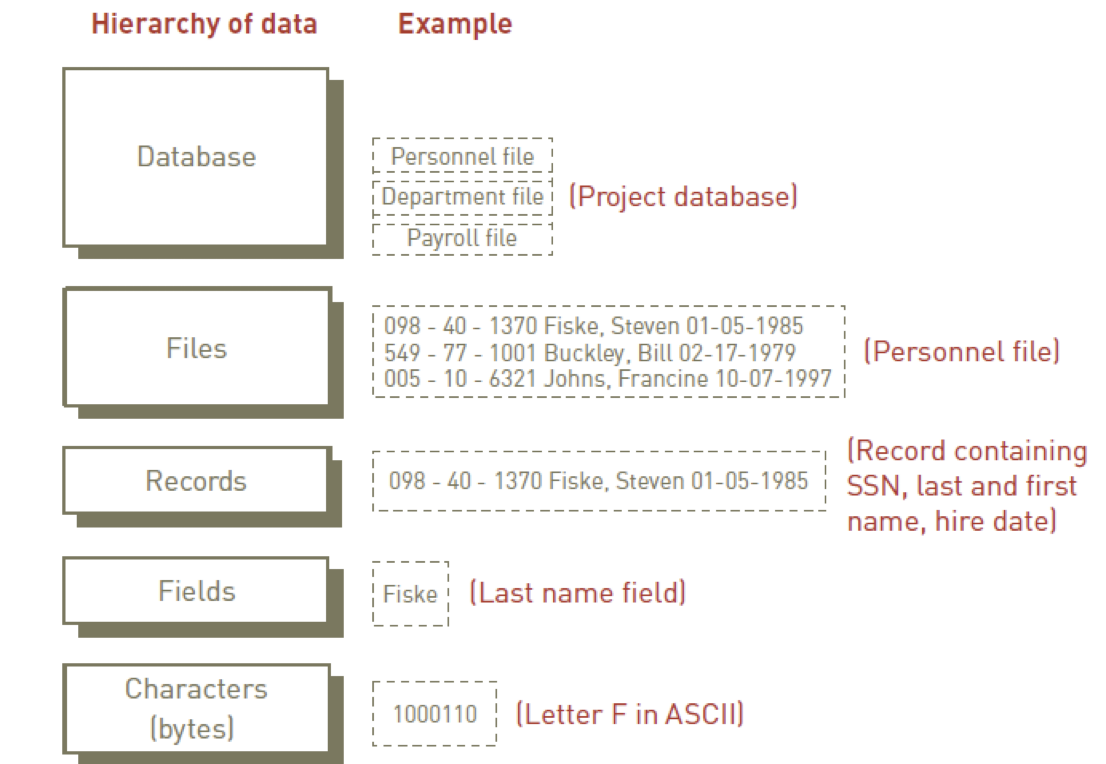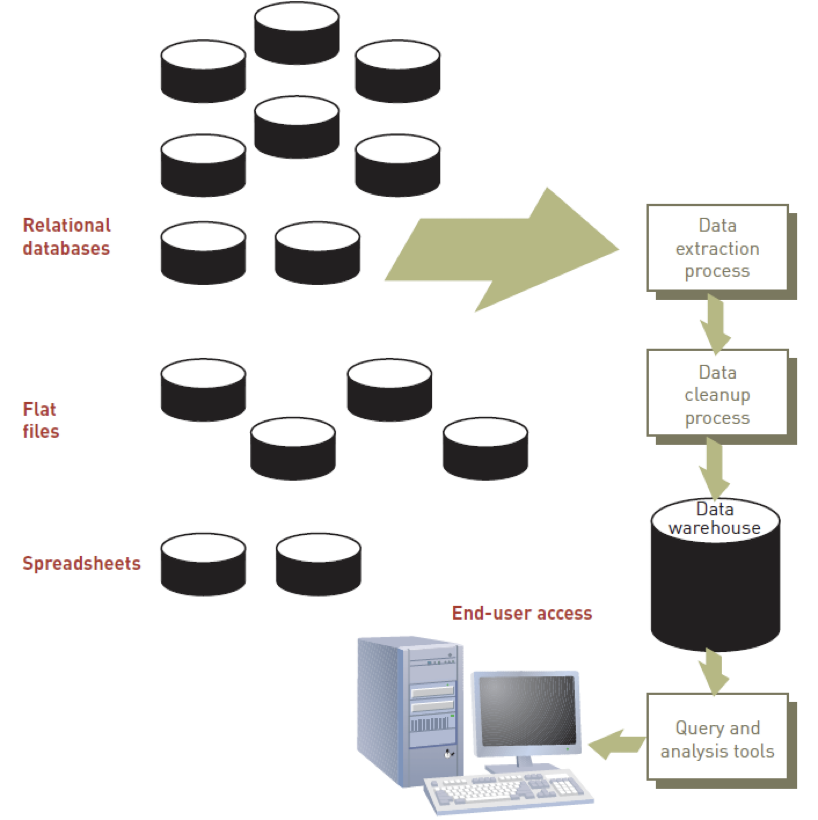Ch 3. Database systems, data centers, and business intelligence
Database: is an organised collection of data
Database management system (DBMS):
- Group of programs that manipulate the database
- Provide an interface between the database and its users and application programs
Database administer (DBA): skilled IS professional who directs all activities related to an organisations database
- An organisation could not complete business activities successfully without data & the ability to process data. Data consists of raw facts, must be organised in a meaningful way
Hierarchy of data:
- Bit (binary digit): circuit that is either on/off
- Byte: made up of 8 bits
- Character: building block of info
- Field : name/number/combo of characters that describes an aspect of a business object or activity
- Record: collection of related data fields
- File: collection of related data records
Database: collection of integrated and related files
Entity: General class of people, places, or things (objects) for which data is collected, stored, and maintained
Attribute: Characteristic of an entity
Data item: Specific value of an attribute
- Key field is the employee number. Attribute includes everything else.
Key: field or set of fields in a record that is used to identify the record
Primary key: field or set of fields that uniquely identifies the record


Approaches to Data Management:
- Traditional: each distinct operational system used data files dedicated to that system
- Database approach: pool of related data is shared by multiple application programs
Some advantages of Database Approach:
- Improved strategic use of corporate data
- Reduced data redundancy
- Easier modification and updating
- Data and program independence
- Better access to data and info: (users give simple commands)
- Better protection of data: (security codes)
Disadvantages of Database Approach:
- More complex
- Difficult to recover from a failure
- More expensive
When building a database, an organisation must consider:
- Content: (what is the data collected?)
- Access: (what data should be provided to which users and when?)
- Logical structure: (how should data be arranged to make sense?)
- Physical organisation: (where should data be physically located?)
Data Center: Is a climate controlled building or set of buildings that house database servers and the systems that deliver mission-critical information and services.
- Traditional data centres: Consist of warehouses filled with row upon row of server racks and powerful cooling systems
Data Modelling: Building a database requires two types of designs:
- Logical design: abstract model of how data should be structured and arranged to meet an organisation’s information needs
- Physical design: starts from the logical database and fine-tunes it for performance and cost considerations
Planned data redundancy: Done to improve system performance to that user reports or queries can be created more quickly
Data model: is a diagram of data entities and their relationships
- Enterprise data modelling: investigates the general data and information needs of an organisation at the strategic level
Entity-relationship (ER) diagrams: data models that use basic graphical symbols to show the organisation of and relationships between data
An entity-relationship (ER) diagram for a customer order database: development of ER diagrams helps ensure that the logical structure of application programs is consistent with the data relationships in the database
The Relational Database Model: Relational Model:
- describes data using a standard tabular format, each row of a table represents a data entity (record), columns of the table represent attributes (fields).
- Domain: allowable values for data attributes In the relational model, all data elements are placed in two-dimensional tables, or relations. As long as they share at least one common element, these relations can be linked to output useful information Manipulating data
- Selecting: eliminates rows according to certain criteria
- Projecting: eliminates column in a table
- Joining: combines two or more tables
- Linking: manipulating two or more tables that share at least one common data attribute
- When looking for information, one needs three tables: project, department, and manager. Every table leads to another, the information is all connected.
Database Management Systems: Creating and implementing the right database system: (ensure that the database will support both business activities and goals)Capabilities and types of database systems vary considerably
Database types:
- Flat file: simple database program whose records have no relationship to one another
- Single user: only one person can use the database at a time (ex: access, filemaker pro, and infopath)
- Multiple users: allows dozens or hundreds of people to access the same database system at the same time (ex: oracle, sybase, and IBM)
Schema: used to describe the entire database
DBMS: can reference a schema to find where to access the requested data in relation to another piece of data
Data definition language (DDL): collection of instructions and commands used to define and describe data and relationships in a specific database. Allows database’s creator to describe data and relationships that are to be contained in the schema
Data dictionary: detailed description of all data used in the database
- Storing and retrieving data: when an application program needs data, it requests it through the DBMS
Concurrency control: method of dealing with a situation in which two or more users or applications need to access the same record at the same time
- Logical & physical access paths: Manipulating data and generating reports
Data manipulation language (DML): commands that manipulate the data in a database
Structured query language (SQL) standard query language for relational databases
- Once a database has been set up and loaded with data: it can produce reports, documents, and other outputs
Database administration (DBA): works with users to decide the content of the database
- Works with programmers as they build applications to ensure that their programs comply with database management system standards and conventions
Data administrator: Responsible for defining and implementing consistent principles for a variety of data issues
- Popular database management systems:
DBMSs can act as front-end or back-end applications:
- Front-end applications interact directly with people
- Back-end applications interact with other programs or applications
Linking database to the internet:
- Semantic web: developing a seamless integration of traditional databases with the internet
- Provides metadata with all web content using technology called the resource description framework (RDF)
Data warehouse: database that holds business information from many sources in the enterprise
Data mart: subset of a data warehouse
Data mining: information-analysis tool involves the automated discovery of patterns and relationships in a data warehouse
- Elements of Data Warehouse:
\n

Predictive analysis: form of data mining that combines historical data with assumptions about future conditions to predict outcomes of events
Used by retailers to upgrade occasional customers into frequent purchasers
Software can be used to analyse a company’s customer list an a year’s worth of sales data to find new market segments
Common data mining applications:
- customer churn
- direct marketing
- fraud detection
- market basket analysis
- market segmentation
- trend analysis
Business intelligence:
- Involves gathering enough of the right information in a timely manner and usable form and analysing it to have a positive impact on business strategy, tactics, or operations
- Competitive intelligence: limited to information about competitors and the ways that knowledge affects strategy, tactics, and operations
- Counterintelligence: steps organisation takes to protect information sought by “hostile” intelligence gatherers
- Data loss prevention (DLP):
- Refers to systems designed with government to lock down data within an organisations
- Powerful tool for counterintelligence
- A necessity in complying with government regulations that require companies to safeguard private customer data
Distributed database:
- Database in which the data may be spread across several smaller databases connected via tele-communications devices
- Gives corporations more flexibility in how databases are organised and used
Replicated database:
- Holds a duplicate set of frequently used data
- Telecommunications systems link the computers so that users at all locations can access the same distributed database, no matter where the data is actually stored
Online analytical processing (OLAP): software that allows users to explore data from a number of different perspectives
- Provides top-down, query-driven data analysis
- Requires repetitive testing of user-originated theories
- Requires a great deal of human ingenuity and interaction with the database to find information
Object-oriented database:
- Stores both data and its processing instructions
- Uses an object-oriented database management system (OODBMS) to provide a user interface and connections to other programs
Object-relational database management system (ORDBMS):
- Provides the ability for third parties to add new data types and operations to the database
Visual databases: can be stored in some object-relational databases pr special purpose database systems
Virtual database systems: allow different databases to work together as a unified database systems
**Spatial data technology:**using database to store and access data according to the locations it describes \n